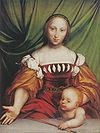
Lais of Corinth (Hans Holbein the Younger)
Encyclopedia

Hans Holbein the Younger
Hans Holbein the Younger was a German artist and printmaker who worked in a Northern Renaissance style. He is best known as one of the greatest portraitists of the 16th century. He also produced religious art, satire and Reformation propaganda, and made a significant contribution to the history...
portrays the famous Lais of Corinth
Lais of Corinth
Lais of Corinth was a famous hetaera or courtesan of ancient Greece who was probably born in Corinth. Another hetaera with the same name was Lais of Hyccara. Since ancient authors in their -usually indirect- accounts often confuse them or do not indicate which they refer to, the two are...
, a courtesan of ancient Greece who charged a high price for her favours. It has been suggested that Holbein is also referring to the Lais who was the lover of Apelles
Apelles
Apelles of Kos was a renowned painter of ancient Greece. Pliny the Elder, to whom we owe much of our knowledge of this artist rated him superior to preceding and subsequent artists...
, the great painter of antiquity (Holbein was called "Apelles" in humanist circles). The model, the same used for Holbein's Darmstadt Madonna and for his Venus and Amor (right), has been identified as Magdalena Offenburg, who may have been Holbein's mistress.

Venus and Amor
Venus and Amor is a c. 1524 painting by the German painter and printmaker Hans Holbein the Younger, conserved in the Öffentliche Kunstsammlung, Basel, Germany. The work is Holbein's earliest mythological painting, and depicts the Roman goddess of love, Venus, with her son Amor...
and, in effect, acts as its companion piece, though Holbein does not appear to have originally planned the second painting. According to some commentators, the portrayal of the sitter as a courtesan may contain a coded message by Holbein about his relationship with Magdalena.
Art historian Peter Claussen, however, dismisses this interpretation as "pure nonsense". Both paintings employ the same colours and depict the same costume and drapery. Holbein adopts the style of Leonardo
Leonardo da Vinci
Leonardo di ser Piero da Vinci was an Italian Renaissance polymath: painter, sculptor, architect, musician, scientist, mathematician, engineer, inventor, anatomist, geologist, cartographer, botanist and writer whose genius, perhaps more than that of any other figure, epitomized the Renaissance...
and the Lombard muralists, whose work he may have studied during a visit to Italy. He uses Leonardo's sfumato
Sfumato
Sfumato is one of the four canonical painting modes of the Renaissance .The most prominent practitioner of sfumato was Leonardo da Vinci, and his famous painting of the Mona Lisa exhibits the technique. Leonardo da Vinci described sfumato as "without lines or borders, in the manner of smoke or...
(smoky) technique to blend the skin tones, as well as the device of the parapet to set the subject back from the viewer.

